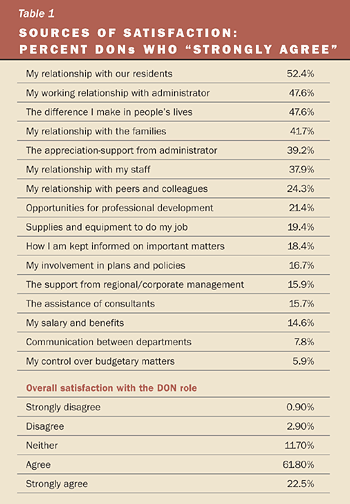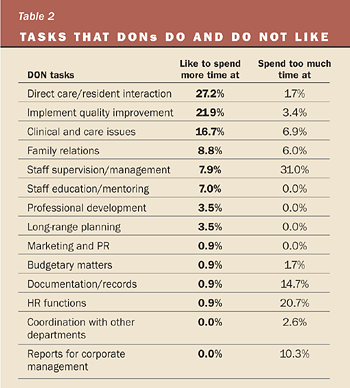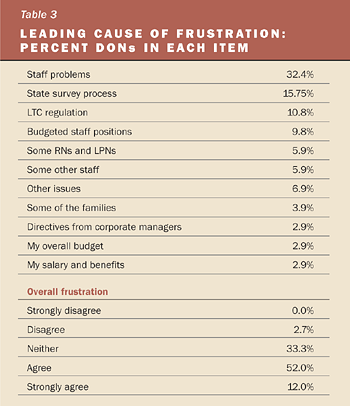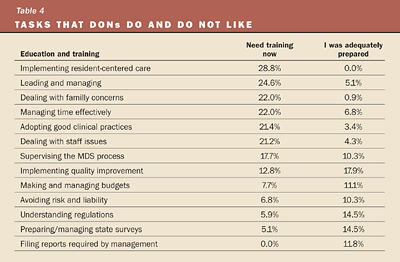BY: V. TELLIS-NAYAK, PhD
Dr. Tellis-Nayak, a principal of MyInnerView, Inc., Wausau, WI, led the research described in his article.
A Study Shows What Directors of Nursing Like and Dislike about Their Roles
|
Summary
Research shows that stable leadership provided by a nursing home's director of nursing (DON) is the foundation of good quality. Conversely, a high DON turnover often results in a quality meltdown at all levels.
A recent study, seeking to uncover the root causes of DON turnover, looked at 103 DONs working in Virginia nursing homes. Although DONs overwhelming affirmed their role and agreed that they were overall satisfied, a majority said they would not choose to be a DON again or recommend the role to others. Not surprisingly, low staff retention rates, mounting administrative responsibilities, growing regulatory and legal constraints, and unrealistic time commitments were the leading causes of frustration.
Given less time to spend on the responsibilities that lie at the very heart of their mission—direct-care and clinical issues, quality improvement, family relations, staff mentoring and professional development—DONS are likely to experience burnout unless long-term care owners and managers reconfigure their role.
|
"What a difference management makes!" concluded Susan Eaton, the noted late Harvard professor, in a report to Congress that referred to her study of staff turnover in nursing homes. Her study showed that managers play a defining role in nursing home quality: They articulate caring values, set a compassionate tone and fashion a humane work-environment that transforms workers into caregivers, who then add quality to the life of residents.1
Research shows that the stable leadership provided by a nursing home's director of nursing (DON), like that provided by its administrator, is the foundation of good quality. Conversely, a high DON turnover often triggers a cascading effect: Staff morale drops, turnover rises, care systems come apart, caregiving suffers, state survey results worsen, satisfaction of staff and families declines, and census falls. Persistent DON turnover, in sum, portends a quality meltdown.2
Viewed through this lens, the 16,317 nursing homes in the nation appear in a gloomy light. In 2002, U.S. nursing homes suffered a DON turnover of 49.7 percent, a 3.1 percent increase since 2001. Turnover at the state level ranged from 14.8 percent to 142.7 percent, with 5.8 percent of DON positions vacant.3 This massive instability in the DON ranks is both a cause and effect of the malaise that afflicts many nursing homes.
A Study of DONs in Virginia
In January 2005, the Virginia Health Care Association collaborated with MyInnerView, Inc., a Wausau, WI-based consulting firm, to study DON turnover in that state. In searching for the root causes, the study used an inductive approach in exploring the total DON experience. Researchers conducted a comprehensive survey of current and past DONs in Virginia. A fair representative sample of 103 current DONs and 15 past DONs returned the completed survey, a return rate of 40 percent. Simultaneously, the researchers undertook an ethnographic study of the DON role in its prescriptive and operational context.
The 103 current DONs in the study had the following profile:
- They were overwhelmingly women (95 percent) of European-American descent (85 percent).
- Eighty percent were older than 40.
- Fifteen percent had no college degree. Forty percent had earned an associate degree, 21 percent were diploma nurses, 44 percent held an associate nursing degree, 28 percent had bachelor's of nursing science degrees, and 6 percent had master's of nursing science degrees.
- About half had been DONs for five years or less. One in five had served as DON for less than a year in her nursing facility.
- Fully half had not attended a single professional meeting or educational session in the previous two years.
- Over half held no membership in any national or state professional association; 28 percent belonged to one such association; and 18 percent belonged to more than one.
A Joyous but Troubled World
One theme surfaced at the very start of the analysis. The DON lives out a daily paradox. On one hand, she takes great pride in her DON role; on the other, she is deeply disaffected from her work. Her profession has trained her to be a nurse-leader with a mission to ensure the resident's well-being; but the realities of health care demand that she function as a director of services accountable for human resources (HR) issues, liability, compliance, and reimbursement. She embraces the former charge as her mission. She resents it when the latter assumes primacy and draws her away from the calling that attracted her to elder care in the first place.
The DONs' words and the survey numbers reveal the joy and great satisfaction they experience in their work.:
- Satisfaction Bordering on Exuberance In glowing, spirited words, the DONs in our study overwhelmingly affirmed their role; 84 percent agreed or strongly agreed that they are overall satisfied. Being a nurse-leader, a DON will tell you, is a rewarding experience.
- Relationships Are Paramount for a Caregiver For a nurse-leader, the measure of success is the bonds she helps create with and among residents, staff members, families, and colleagues. Relationships are a caregiver's implicit compliment, satisfying reward, and sustaining motivation. Relationships show up in the top 7 out of the 17 most important sources of a DON's satisfaction.
- Not a Self-Focused Satisfaction Salary, professional growth, help from consultants, and the supplies and equipment they need-these may or may not be adequately available to a DON. But they neither boost her satisfaction nor fuel her frustration.

Caregiving is the DON's calling. What satisfies her most is resident care (52 percent) and knowing that she makes a difference in people's lives (47 percent). A DON's greatest reward, as one respondent expressed it, is in "the difference I make in people's lives, in seeing the progress residents make, watching staff develop professionally. Nothing is more gratifying than the feeble 'Thank you, honey,' the touch of a frail hand, or the heartwarming smiles I am blessed with every day."
This joyous world of the DON, however, is not free of clouds of uncertainty, which hover over the five measures of DON commitment we used. Even as she strongly affirmed her role, the typical DON in our study turned cautious when asked whether, given the opportunity, she would choose to be a DON again or would recommend the role to others. Although a great many DONs agreed or strongly agreed that they are satisfied being DONs (84 percent), far fewer said they would choose to be DONs again (70 percent). Fewer still said they would recommend the DON role to others (52 percent).
These sentiments forebode a grim tomorrow. Three out of five DONs in our study said they had thought seriously about quitting in the previous six months. More than half would walk out now, if it were possible. One in five would leave long-term care altogether. One in six plan to leave the field within the next two years. More than half said they would leave it within five years.
Roots of Distress
What lies at the root of the DON's distress? What is pushing her to the edge? An answer emerges when one considers those aspects of a DON's work that satisfy her the least and frustrate her the most—the tasks that occupy much of her time and leave her little room to address issues she would rather devote herself to.

Direct-care and clinical issues, quality improvement, family relations, staff mentoring, and professional development—these responsibilities lie at the very heart of a DON's mission. They are areas she wishes she were engaged in more. In fact, during a typical day the DON is saddled with responsibilities far removed from care issues. Budgeting, planning, and interdepartmental communication do not stir her heart or contribute to her satisfaction. Long-range planning, HR functions, documentation, and marketing, are part of the organization of care. Still, they fall outside the DON's core expertise; they overwhelm her workday.
Add to all these burdens the other sources of her frustration, and one begins to understand why almost two in three DONs agree, or strongly agree, that they are frustrated in their jobs.
Not once during our study did a DON speak positively about her role without adding negative comments. A typical comment was: "I very much enjoy being a DON, but (the job demands) have taken away the 'why' I wanted to work with residents." Another said, "I want to do a good job as a DON, but I am unable to accomplish important clinical programs."
The idealistic world of a DON's calling, in which she would gladly stay immersed, is not a protective cocoon; it is nested in and interlocked with the complex health care economy. Thus the DON not only has to heed the call of the bedside; she must also respond to her employer's policies and prescriptions, to government regulation, and to the realities of the labor market.

Labor Market Demands Staffing problems are severe in nursing homes. In our survey, they were the leading cause of DONs' frustration (32 percent). The typical DON spends an inordinate amount of time hiring staff, juggling schedules, calling in agency help, or stepping in when the unit is short-staffed.
Little wonder that less than 2 percent of DONs work only 40 hours a week; 56 percent of them put in over 50 hours, and half of these log up to 60 hours. The staffing crunch taxes a DON's ingenuity. "I tried partial shifts, 12 hour shifts, anything and everything," said a respondent. "But without adequate coverage, it is difficult to take care of residents. There is no down time. I am on call all the time. Who needs this aggravation?"
Unrealistic time commitments push DONs, especially the younger ones, towards the exit door. "Younger DONs will not stay for long," said another respondent. "They have young families, and being a DON is not compatible with rearing a family. It comes down to: 'Do I want my job or my family?'"
Regulatory and Legal Constraints
Regulation and the threat of liability have in effect redefined the DON as part compliance officer, part traffic cop, and part paper-pushing bureaucrat. One DON said, with sadness, "My job focuses too much on corporate and state compliance and paperwork. I would love to spend more time with residents. I look forward to wound-rounds on Fridays, just so I can spend some more time with our residents."
Researchers heard this familiar litany at every turn. State surveys give primacy to compliance over quality. Regulation sometimes burdens the caregiver more than it improves care. Minimum data set (MDS) documentation—which the Centers for Medicare & Medicaid Services require for all residents covered by those services—robs time from direct care. Thinking about MDS, a DON tends to avoid risk, her eye more on the courtroom than on the bedside. "Here is the recipe for making the DON position less and less desirable to nurses," a respondent said. "Start with job stress, add liability, mix in stricter and stricter regulation, and top it off with a demeaning survey process."
The system rewards an amoral hypocrisy. "MDS requires we use RNs to chase paperwork and to create nonworking care plans that are useless to the floor nurse who has no time to read 60 care plans that contain eight to nine problem areas," said a DON. "The concept of the working care plan has been lost in the MDS bureaucracy. We would serve our residents better by putting the RNs right by the bedside, giving care, doing assessments, and developing a short, evolving working care plan."
State surveys are a sore issue with DONs. They concede that the Federal Nursing Home Reform Act of 1987 (sometimes called "OBRA '87" because it was part of the Omnibus Budget Reconciliation Act of that year), which set standards for resident care, was a fine thing. It is, DONs say, the way these high ideals have been reincarnated in a state survey system that bothers them. As one respondent said, "We deal with the very frail elderly. They are tired and they hurt from arthritis and cancer. They don't want to perform range-of-motion three times a day or be carted to every activity. They want to rest and to be quiet in their rooms. Yet we are cited if we don't have time to document all the reasons why they refused the other alternatives we tried."
Another DON added, "Nurse assistants come in daily and lift, feed, shave, comb hair, give baths, clean up urine and feces. They make life-and-death decisions. They support families and friends of the resident. State surveyors should be handing out medals, rather than consistently handing out punitive citations. CNAs should be appreciated for dealing with the most valuable and precious thing on earth—life. Something is wrong! We have lost sight of what is good and what is foolish, what is quality of care and what is not."
"The survey does not focus on resident outcomes, but on the process," a third DON said. "The resident outcomes may be positive, but you are cited for not following the [prescribed] process," noted another. "We are guilty until proven innocent with the surveyors," said yet another. "It is during the survey process that you most frequently question why you are doing this job."
Awesome Mission, Meager Preparation
The DON's role is pivotal; its responsibilities have proliferated far beyond a nurse-leader's reach. Yet Virginia, which allows any RN to serve as a DON, is one of 29 states that do not require RNs to have continuing education in order to renew their license. Over half of the DONs in the study had less than a four-year college degree. Only one in three had a bachelor's degree in nursing. Over half belonged to no professional association. Over half had attended no professional meeting in the previous two years.
The DONs bemoaned the consequence. "We DONs are not educated for this job," said one. "It is mostly an administrative job requiring clinical knowledge. I have succeeded in my job because I had an MBA when I took the job." "I have learned a great deal about managing and motivating people," said another. "Unfortunately, I learned it all the hard way." "I have been a DON for three years," said a third. "I had been out of nursing for 15 years. They hired me without any long-term care experience. Why did I do it? Honestly, I care about quality; and I thought, it cannot be too hard. Would I do it again? No!"
Do DONs feel they were prepared to step into their role? The respondents in our survey said that, before taking their current jobs, they had been adequately trained and had sufficient experience in the nursing field. They were well- grounded in resident care, clinical programs, and family concerns. And they felt confident about leading and managing caregivers.
However, they also said they were not well prepared in the nonclinical responsibilities that come with the job: managing state inspections, liability, budgets, and HR issues. They put such topics on their priority list for continuing education.
The DONs in our study considered clinical expertise their forte, not the implementing of continuous quality improvement (CQI) monitoring systems. CQI calls for a systems approach, which, they said, neither their education nor training had adequately addressed. They acknowledged that they felt diffident about such systems, but saw their value and gave them high priority on their continuing-education wish list.

Empowerment: A Two-Edged Sword
Does prior training minimize frustration and increase satisfaction? Our analysis showed that it does both to a modest degree, but it also revealed some surprises. Better-educated DONs said they were better prepared for the DON's job and were more satisfied and less frustrated with it. The better educated were more likely to be members of professional associations, were less likely to recommend their role to others, more likely to think about quitting, and more likely to be gone in five years. These tendencies were more pronounced among DONs with higher nursing degrees.
These patterns again confirm that education does more than merely impart skills and shape the mind. It also builds self-image and opens horizons of thought and opportunity. Advanced nursing education gives DONs highly marketable skills. When they find themselves in difficult situations, they don't feel trapped or very frustrated. They simply weigh their options and plan their exits.
This finding poses a dilemma for the employer who wants to empower staff and support staff education, new skills, critical thinking, and career ladders. Should such an employer empower staff members—only to see the younger and better-educated ones leave? Alternatively, should the employer seek to increase staff retention by pursuing what is inelegantly labeled the "mushroom philosophy" of management ("Keep them in the dark, and feed them manure")? The answer lies in a simple truism: One cannot encourage staff education without improving the quality of the workplace. Staff stability is nurtured in a work climate that encourages professional growth and creativity, respects individuality, and celebrates staff contribution.
The complex paradox of the DON experience exacts a price. Younger DONs leave, and the average age of DONs keeps inching up. The better qualified seek other careers, and the average educational level of DONs keeps falling. Many of those left behind will not recommend their position to others; half will quit when they can, or will likely be gone in five years. Recruitment becomes difficult, and DON positions lie vacant.
DONs may be self-sorting themselves into two distinct groups. On one side are the irrepressible, highly motivated DONs, whom one can count upon to fight the good fight. On the other side are the battle-scarred and disaffected DONs, who report to duty because they lack other options.
In our study, two DONs illustrated this conclusion. One said, "My position offers me many opportunities to affect the lives of many. My team practices the art of nursing in all its aspects, caring for residents in the end stages of life and death. It is nursing in its entirety. To be a DON is rewarding yet frustrating, taxing, and extremely demanding and invasive of personal time. It limits personal planning, education, and growth. And I love it! I remain determined that each time I walk into our building I will make a difference in the life of our residents, staff, families, and community."
The other DON said, "It has been a great and awful experience. I don't want to be a DON five years from now. I hope to move on to other areas, where I don't have to keep awake most nights!"
Adding quality to the life of our frail elders is a special vocation. We should count ourselves blessed that many exceptional and devoted DONs have responded to that call. The incongruities of their lives, however, are eroding their commitment and destabilizing their ranks. As the typical DON stoically endures yet another day of challenge, she is conveying a silent but clear message to all those who have a hand in shaping her role.
To her profession and professional associations, the DON is saying, "Devise curricula, standards, and qualifications for DONs. Address their need for skills to manage time and budgets and to implement systems that improve and monitor care. Devise peer-monitoring and mentoring systems."
To long-term care owners and managers, she is saying, "Reconfigure the DON role. Reassign the DON's HR and bureaucratic functions to other employees. Remove unreasonable demands on her time and personal life. Regularly review the DON functions and affirm her role as a caregiver-leader. Invest in DON orientation and professional development."
To legislators and regulators, she is saying, "Bring reason, humanity, and customer service back into the state survey system. Support a process that affirms excellence, rewards achievement, mentors the underachievers, prods the mediocre, and punishes the chronically delinquent."
To researchers and others who influence policy, she is saying, "Give visibility—through research, seminars, workshops, and other initiatives—to the pivotal role nurse-leaders play in nurturing and sustaining a culture of quality. Launch an action-research to systematically harvest, integrate, and publicize the innovative ideas, successful models, and best practices that DONs and some providers are involved in around the nation.
"And devise simple, effective ways to track across long-term care the satisfaction, turnover, stability, and length of service among DONs—these constitute the nation's barometer of quality in long-term care."
NOTES
- S. C. Eaton, "What a Difference Management Makes: Nursing Staff Turnover Variation within a Single Labor Market, " in Abt Associates, eds., Report to Congress; Appropriateness of Minimum Nurse Staffing Ratios in Nursing Homes: Phase II Final Report, Cambridge, MA, 2002, available at www.cms.gov/medicaid/reports/rp1201home.asp.
- N. G. Castle, "Turnover Begets Turnover," Gerontologist, vol. 45, no. 2, April 2005, pp. 186-195; V. Tellis-Nayak, Troubled Leaders at the Frontline: Stability and Turnover among Nursing Home Administrators and Directors of Nursing, research findings presented at the Fellows and Certified Members Institute, American College of Health Care Administrators, Charleston, NC, 2003.
- American Health Care Association, Results of the 2002 AHCA Survey of Nursing Staff Vacancy and Turnover in Nursing Homes, Washington, DC, 2003, pp. 14-15, available at www.ahca.org/research/rpt_vts2002_final.pdf.
CHA, MyInnerView Sign Agreement
MyInnerView conducts research and provides evidence-based management tools that support long-term care providers' quality-improvement efforts. Under an agreement with CHA, special discounts are available, until March 1, 2006, for CHA member nursing and assisted-living facilities on MyInnerView's Quality Profile and Risk Monitor programs. Information on MyInnerView's research and products is available at (715) 848-2713 or www.myinnerview.com.
Copyright © 2005 by the Catholic Health Association of the United States
For reprint permission, contact Betty Crosby or call (314) 253-3477.